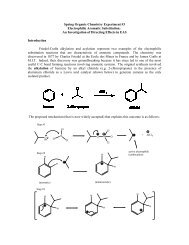Fall Organic Chemistry Experiment #7 Spectroscopic Analysis by ...
Fall Organic Chemistry Experiment #7 Spectroscopic Analysis by ...
Fall Organic Chemistry Experiment #7 Spectroscopic Analysis by ...
- No tags were found...
You also want an ePaper? Increase the reach of your titles
YUMPU automatically turns print PDFs into web optimized ePapers that Google loves.
<strong>Fall</strong> <strong>Organic</strong> <strong>Chemistry</strong> <strong>Experiment</strong> <strong>#7</strong><strong>Spectroscopic</strong> <strong>Analysis</strong> <strong>by</strong> GCMS, NMR, and IRSuggested ReadingLehman The Student's Lab Companion: Laboratory Techniques for <strong>Organic</strong> <strong>Chemistry</strong>Operation #37 Gas Chromatography pages 245-256Operation #39 Infrared Spectroscopy pages 260-289Operation #40 Nuclear Magnetic Resonance Spectroscopy pages 289-306Operation #42 Mass Spectrometry pages 313-323*** It is critical that you spend the time doing the assigned reading prior to coming to lab.These excerpts will not only prepare you for what you’ll be doing in lab, but will alsoreinforce what we’re doing in class and help you to get more practice.Procedure:You will analyze products from last several experiments.<strong>Experiment</strong> #4 – Goal: identification of the product of the Mitsunobu reaction<strong>Experiment</strong> #5 – Goal: identification of the early and late distillates from fractional distillation<strong>Experiment</strong> #6 – Goal: identification of the percentages of isomers from resolutionYou will collect 1 HNMR and 13 CNMR data for the Mitsunobu product from <strong>Experiment</strong> #4.You will collect IR, 1 HNMR, 13 CNMR, and GCMS for the early and late distillates from<strong>Experiment</strong> #5. You will collect 1 HNMR data only for the resolved enantiomer from <strong>Experiment</strong>#6.Your job is to identify all major pieces of structural information from the collected sets of spectraldata. It may be very helpful (HINT) to verify your results <strong>by</strong> consulting the “Aldrich Library ofFT-IR Spectra” and the “Aldrich Library of FT-NMR Spectra” that can be found in the sciencereference section in the Wilmot Library or any one of a number of on-line databases of spectralinformation. You can also use one of the spectral predictors available on the web.Your success depends upon your ability to:(1) learn how to acquire a spectrum (manual and automated) on the IR, the GCMS, and the NMRspectrometers.(2) learn how to work up the data using the OMNIC IR data processing software and the Acorn“NUTS” NMR processing software. All of these functions will be demonstrated using theinstruments in Smyth 302 and the computer workstations in Smyth 303 or Smyth 243.Come prepared to take notes in your laboratory notebook. A copy of the NUTS tutorial andthe guidelines for using the NMR console can be accessed <strong>by</strong> clicking on the links through theorganic course web site. PLEASE REVIEW THESE PAGES PRIOR TO COMING TO LAB!(a) for the identification of the product of the Mitsunobu reaction (Exp. #4)Prepare a sample for NMR analysis (50 mg) as demonstrated <strong>by</strong> your lab instructor. Acquire 1 Hand 13 C NMR spectra. Again, you can follow the instructions that are available on the organicchemistry course web site (NMR console).(b) for the identification of the early and late distillates from fractional distillation (Exp. #5)
Transfer some of your sample (both early and late distillates) from your storage vial into a GCMSvial. Proceed to S302 (instrumentation room) and program the instrumental method and sequenceinformation (according to the steps laid out <strong>by</strong> the lab instructor). Place your vial in theappropriate slot in the autosampler. The last group to load a sample will start the automationsequence to acquire the data.Once completed, collect an IR spectrum for each of the early and late distillates <strong>by</strong> first collectinga background spectrum and then a sample spectrum for each (as demonstrated <strong>by</strong> your labinstructor). Work-up the data using the OMNIC software and print spectra with peak picking foreach member of your team.Finally, prepare a sample for NMR analysis (50 mg) as demonstrated <strong>by</strong> your lab instructor.Acquire 1 H and 13 C NMR spectra for both your early and late distillates. Again, you can followthe instructions that are available on the organic chemistry course web site (NMR console).(c) for the identification of the ratio of isomers isolated <strong>by</strong> fractional crystallization (Exp.#6)Using a small test tube, weigh approximately 0.35 mmole of your resolved amine <strong>by</strong> adding itdrop <strong>by</strong> drop from a Pasteur pipet. Cork the test tube. Weigh out approximately 0.40 mmole of(S)-(+)-O-acetylmandelic acid and add it to the amine in the test tube (Why are we doing this?).Using a clean Pasteur pipet, add about 250 uL of CDCl 3 /TMS to dissolve everything. If the soliddoes not completely dissolve, you can mix the solution <strong>by</strong> drawing it several times into the pipetand redelivering back into the test tube. When everything is dissolved, transfer the mixture to anNMR tube (filter through a cotton-plugged Pasteur Pipet) and add enough CDCl 3 /TMS tobring the total height in the tube up to 35 mm (IT IS IMPORTANT THAT THE TUBE BEBETWEEN 1/3 and 1/2 FULL – no more, no less). Acquire a 1 H-NMR spectrum. Work upyour raw data (an FID) using the NUTS data processing software. Be sure to provide close-upviews of the split peak clusters with integration to determine the percentages of eachisomer.
















